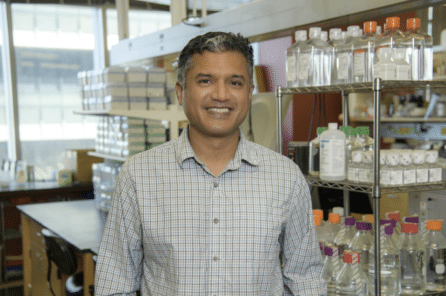Giving Cells an Invisibility Cloak
NewsThe Context: Cell therapies hold enormous promise for treating many of today’s most devastating diseases, but for them to be effective, we have to ensure that any new cells introduced into the body aren’t attacked by the immune system. Making cells that can evade the immune system is seen as ‘the holy grail’ for delivering cell therapies to patients.
The Study: By introducing certain genetic modifications to transplanted human cells, a collaborative team led by NYSCF – Robertson Stem Cell Investigator Alumnus Deepta Bhattacharya, PhD, of the University of Arizona and including NYSCF scientists found that these cells could evade the immune system in mice. The study appears in Stem Cell Reports.
The Importance: This study uses a rigorous testing method to provide critical information that can be used to develop safe and effective cell therapies, and can be applied across a variety of diseases.
Cell therapies are one of the most promising applications of stem cells, since they have the potential to address the root cause of diseases by introducing healthy cells made from stem cells into the body. The main hurdle, however, is that our immune system is suspicious of any new cells it doesn’t recognize, requiring patients who receive cell therapies to undergo potentially harmful immunosuppression.
“There has been a lot of excitement for decades around the field of pluripotent stem cells and regenerative medicine,” Dr. Bhattacharya said in an article from The University of Arizona. “What we have learned from the experiences of organ transplantation is that you have to have matched donors, but the person receiving the transplant often still requires lifelong immunosuppression, and that means there is increased susceptibility to infections and cancer. We’ve been trying to figure out what it is that you need to do to those stem cells to keep them from getting rejected, and it looks like we have a possible solution.”

Genetic Tricks for Invisibility
So how do you give a cell an invisibility cloak? The answer lies with genetic engineering.
Previous research has identified many genes that are involved in triggering an immune response, and the scientists decided to use gene editing to inactivate some of these genes, hopefully letting cells slink around the body unnoticed.
To test this, they put their modified human cells up against what could be its most formidable opponent: a mouse immune system.
“Transplantation across species, across the xenogeneic barrier, is difficult and is a very high bar for transplantation. We decided if we could overcome that barrier, then we could start to have confidence that we can overcome what should be a simpler human-to-human barrier, and so that’s basically what we did,” explained Dr. Bhattacharya.
Excitingly, the cells cleared this barrier, effectively integrating into the mice without stimulating an immune attack, with NYSCF scientists confirming the survival of the transplanted cells.

“This is an incredibly exciting result, as it suggests this kind of ‘immune camouflaging’ could be effective in patients,” remarked NYSCF Principal Scientist and NYSCF – Lisa Dean Moseley Foundation Fellow Paula Alonso-Guallart, DVM, PhD. “At NYSCF, we have a special focus on leveraging this approach to develop a cell therapy for type 1 diabetes, and this work brings us closer to realizing that goal.”
“That has been the holy grail for a while. You might actually have a chance of being able to perform pluripotent stem cell-based transplants without immune suppressing the person who is receiving them. That would be an important advance, both clinically and from the simple standpoint of scale,” added Dr. Bhattacharya. “You wouldn’t have to make individualized therapies for every single person – you can start with one pluripotent stem cell type, turn it into the cell type you want and then give it to almost anyone.”
Read more from:
Journal Article:
Engineering human pluripotent stem cell lines to evade xenogeneic transplantation barriers
Hannah A. Pizzato, Paula Alonso-Guallart, James Woods, Jon P. Connelly, Todd A. Fehniger, John P. Atkinson, Shondra M. Pruett-Miller, Frederick J. Monsma Jr., and Deepta Bhattacharya. Stem Cell Reports. 2024. DOI: https://www.cell.com/stem-cell-reports/fulltext/S2213-6711(23)00496-4

